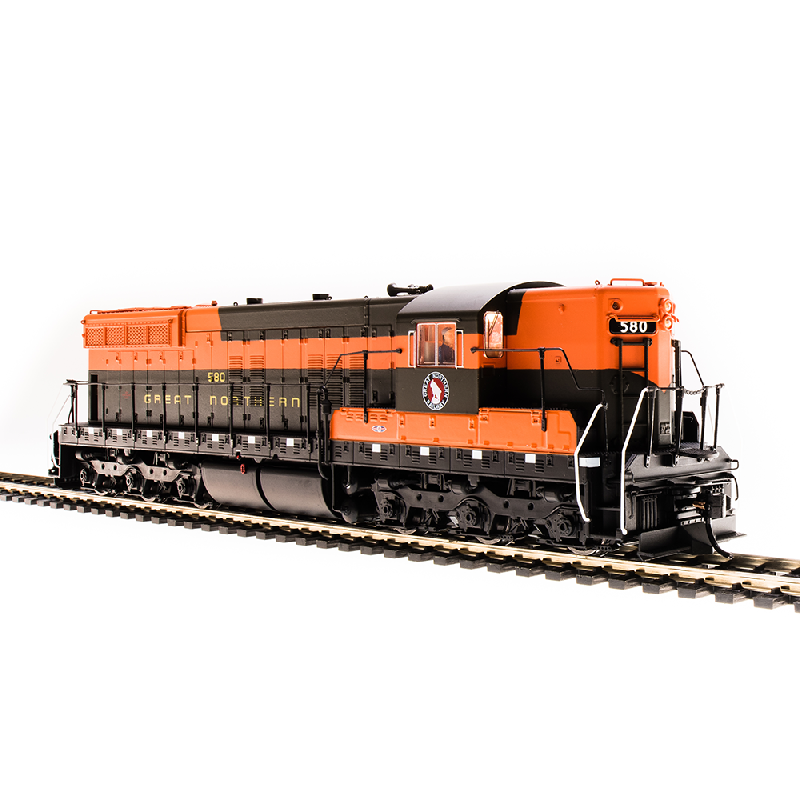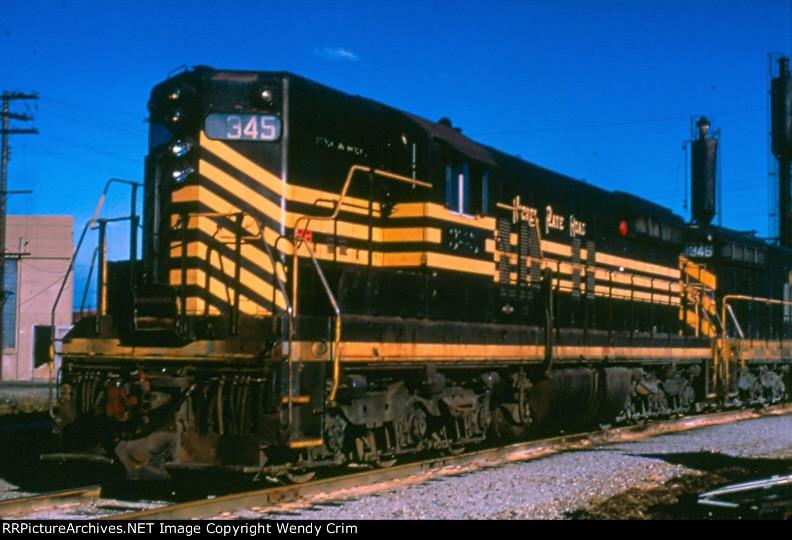EMD SD9 (Standard DC) Southern Pacific No. 5432 Limited Edition! The debut of the SD9 in 1954 marked the next step forward for EMD's Special Duty line of six-axle diesels, and introduced the new 567C prime mover delivering 1,750 horsepower. Rated 5.00 out of 5 based on 1 customer rating (1 customer review) Log in to Purchase $ 14.99. JointedRail content is currently supported ONLY in. EMD SD9 #189 SOLD. EMD SD9 #189 SOLD. EMD GP7 #2106 SOLD. EMD GP7 #2106 SOLD. EMD GP9 #4605 SOLD. EMD GP9 #4605 SOLD. The debut of the SD9 in 1954 marked the next step forward for EMD's Special Duty line of six-axle diesels, and introduced the new 567C prime mover delivering 1,750 horsepower. BN SD9 6103 and SD7 6013, both still in Big Sky Blue, couple to a former NP caboose wearing NP's final caboose colors which was close to BN's caboose scheme. During this time it was common to see. Railroad: Burlington Northern Railroad Locomotive: EMD SD9 Location: Superior, Wisconsin, USA Locomotive #: BN 6103 Train ID: Unknown.

The Electro-Motive Division's SD24 began the company's entry into the manufacturing of second-generation diesel locomotives. Interestingly, while the model offered new features it kept many of the standard features of the early first-generation Special Duty locomotives like the SD7, SD9, and SD18. It had yet to feature the new Spartan Cab design and stuck with the tapered nose of the SD18. All of this would, change, however, when EMD released the SD28 in 1965. In any even, the locomotive saw modest sales although just a handful of railroads would buy it with most orders taken by the Atchison, Topeka & Santa Fe Railway (the Santa Fe). The SD24 was also the only six-axle model to have cabless B units built.
Today, none are known to still be in use for freight service although regional Pan Am Railways keeps two rebuilt as SD26s stored. Also, two others are known to be preserved, Chicago, Burlington & Quincy #504 is completely restored at the Illinois Railway Museum while the National Railroad Museum has CB&Q #510 partially restored.
The SD24, which debuted in July, 1958 and remained in EMD's catalog through March, 1963 was one of the company's rarer designs that did not sell particularly well in comparison to the early Fs as as the GP7 and GP9. However, it is featured here primarily because of its significance as EMD’s leap into second-generation power for six-axle locomotives. The unit was virtually identical to her GP30 (B-B trucks) sister in most aspects except that she carried 2,400 hp instead of the GP30’s 2,250 hp. For instance, the SD24 featured the very same 16-cylinder 567D3 and featured an airtight hood that kept out dust, dirt, and other particles from reaching internal components (to cool these critical components the SD24 featured a single air intake for electrical cooling, with a pressurized cooling system). It was these latter features that, in particular, classed the locomotive as a second-generation design.
Other Well-Known 'Special Duty' Models
The SD7, EMD's First Six-Axle Road-Switcher
The SD35, Growing Six-Axle Popularity
The SD38 Series, Featuring The New 645
The Blockbuster SD40/SD40-2 Series, The Gold Standard
The Powerful, 20-Cylinder SD45 Series
The SD50, Electro-Motive's Downfall
The Successful SD70 Series
The SD24's primary purpose was that the extra two axles produced more traction (which allowed the locomotive to handle stiffer grades), allowed for better weight distribution (which was a big plus on light rail and bridges unable to support heavy loads, found on many branch lines) and its Flexicoil trucks allowed for ease of maintenance on its center traction motor. Another significant difference with the SD24's internal components was its use of General Motors model D47 traction motors, as opposed to the GP30's model D57. Up to that time the SD24 offered the most tractive effort of any of EMD's six-axle models; 97,500 pounds starting and 72,300 pounds continuous.
The SD24 was officially EMD's first to feature turbocharging, a concept that actually dated back to 1955 and 1956 in tests by the Union Pacific to equip its own GP9s with the feature to boost their horsepower. These units became known as Omaha GP20s. At the time, the railroad was wanting and needing higher horsepower locomotives to help move heavier freight trains along its main lines west of Wyoming. EMD was hesitant to turbocharge its own 567 prime mover but after the successful test by Union Pacific went forward with the concept. The SD24 was the first to be cataloged with the feature and more than a year later in November, 1959 the four-axle GP20 went on sale with a turbocharged 567.
Of course, turbocharging was nothing new and certainly not pioneered by EMD. The American Locomotive Company had been turbocharging its road switchers since the 1940s and was so good at it that typically Alco models were very fuel efficient while offering comparable, if not better, horsepower ratings than the competition. While the SD24 was not as successful as its early sisters it did pave the way for future second-generation six-axle models that would become legendary for their durability and reliability like the SD40, SD40-2, SD45, and others.
EMD SD24 Production Roster

| Owner | Road Number(s) | Quantity | Date Built |
|---|---|---|---|
| Burlington | 500-515 | 16 | 1959 |
| Cincinnati, New Orleans & Texas Pacific (Southern) | 6305-6325 | 21 | 1960 |
| Kennecott Copper Corporation | 904 | 1 | 1963 |
| New Orleans & Northeastern (Southern) | 6950-6953 | 4 | 1959 |
| Santa Fe | 900-979 | 80 | 1959-1960 |
| Southern Railway | 2502-2524 | 23 | 1959 |
| Union Pacific | 400-429, 445-448 | 34 | 1958-1960 |
| Union Pacific | 400B-444B (SD24B) | 45 | 1959 |
While the SD24 was offered with an optional steam boiler no railroads ever purchased such for use in passenger service. Additionally, only Kennecott Copper's one unit, #904, did not feature multiple-unit capability (MU). In total, the railroads which went on to purchase the locomotive included the Santa Fe (80, numbered 900–979), Burlington (16, numbered 500–515), Southern/Cincinnati, New Orleans & Texas Pacific/New Orleans Northeastern (48, numbered 2502–2524, 6305–6325, and 6950–6953), and Union Pacific who purchased the only B units (30 As numbered, 400–429 and 45 Bs, 400B–448B). Additionally, EMD's four demonstrators went to UP.
- › ›
The EMD SD9, also referred to as a 'Cadillac' for the smooth, soft ride, was the builder's second model in its six-axle series and looked virtually identical to the SD7. Slightly more powerful than its predecessor and using an updated version of General Motors' proven prime mover of the time, the model 567, the SD9 was the most successful first-generation six-axle locomotive EMD produced, selling more than 500 examples (which included sales to foreign railroads). Apparently, the bump up in horsepower convinced more lines to try the locomotive. Still, the Electro-Motive Division found sales difficult with numerous future six-axle models. Until the SD40 was released in 1966 only the SD24 and SD35 sold more than 100 units for the company. As with many early model EMDs the SD9 soldiers on today, finding use in regular service on shortlines and industrial settings. There are also several units officially preserved including Colorado & Southern #839 and Southern Pacific #5428, #5363, #5468, and #5472.
The EMD SD9 began production in early 1954, soon after the SD7 line was closed. The model used GM's latest prime mover of the time, the 16-cylinder model 567C which provided the SD9 a 1,750 horsepower rating, 250 more horsepower than the earlier SD7. Also, using GM's model D47 traction motors the C-C truck setup provided for a continuous tractive effort of 75,000 pounds (its starting tractive effort was nearly 91,000 pounds), which also closely mirrored the SD7. While the locomotive had the option of an added steam boiler for use in passenger service only a few railroads would include the feature with their SD9s including the Duluth, Missabe & Iron Range Railroad, Burlington, and Southern Pacific.
Related Reading You May Enjoy
EMD's General Motors Diesel
Early Switchers: SW, SC, NW, NC

Emd Sd 9 Drawing
'Cow-Calf' Switchers
Emd Sd9 Cab
NW2
SW1
SW7
SW8
SW9
SW900
SW1000
SW1001 Variant
SW1200
SW1500
EMD's E Series
Rock Island's Unique AB6
E7
E8


EMD's F Series
FT
F2
F3
F7
FP7
F9
New Haven's FL9
F40PH Series
F45 Series
Emd Sd9 Manual
Great Northern's GP5
GP7
GP9
GP15 Series
GP18
RS1325
GP20
GP30
GP35
GP38 Series
GP40 Series
GP50
SD18
SD24
SD35
SD38 Series
SD40/SD40-2 Series
SD45 Series
SD50
SD60 Series
SD70 Series
SD75M/I Variant
Conrail's SD80MAC
SD90MAC
SD70ACe
The Southern Pacific was one of the first railroads to take notice of the extra tractive effort EMD's Special Duty line provided, especially in mountainous operations, and purchased the most SD7s by a single company. They likewise purchased the most SD9s, buying 150 of the 471 total sold to domestic railroads (another 44 were purchased by foreign lines). While the 515 SD9s ultimately sold paled in comparison to the more than 4,000 four-axle GP9s outshopped, more railroads took notice of the latest six-axle design with more than a dozen Class Is purchasing the model. Many of the companies that purchased the SD9 had also bought or tested at least one SD7.
In any event, buyers included the Atlanta & St. Andrews Bay Railroad (3, numbered 503–505), Baltimore & Ohio (10, numbered 765–774), Burlington (80, numbered 325–374, 430–459), Colorado & Southern/CB&Q (23, numbered 820–842), Central of Georgia (6, numbered 202–207), Chicago & Illinois Midland (5, numbered 50–54), Chicago & North Western (14, numbered 1701–1710, 1721–1724), Milwaukee Road (14, numbered 2224–2237), DM&IR (73, numbered 101–109, 111–174 although just two came equipped with steam generators), Rio Grande (10, numbered 5305–5314), Elgin, Joliet & Eastern (3, numbered 600–602), Great Northern (27, numbered 573–599), Nickel Plate Road (20, numbered 340–359), Pennsylvania Railroad (25, numbered 7600–7624), Reserve Mining (6, numbered 1220–1225), Soo Line #2381, and SP's 150 (numbered 5340–5444, 5449–5493).
EMD SD9 'Cadillac' Production Roster
| Owner | Road Number(s) | Quantity | Date Built |
|---|---|---|---|
| Atlanta & St. Andrews Bay | 503-505 | 3 | 1956-1958 |
| Baltimore & Ohio | 765-774 | 10 | 1954-1955 |
| Burlington | 325-374, 430-459 | 80 | 1954-1957 |
| Central Of Georgia | 202-207 | 6 | 1955 |
| Chicago & Illinois Midland | 50-54 | 5 | 1955 |
| Chicago & North Western | 1701-1710, 1721-1724 | 14 | 1954-1955 |
| Colorado & Southern Railway (CB&Q) | 820-842 | 23 | 1957-1959 |
| Denver & Rio Grande Western | 5305-5314 | 10 | 1957 |
| Duluth, Missable & Iron Range | 101-174 | 75 | 1955-1959 |
| Electro-Motive (Demo) | 5591 | 1 | 1955 |
| Elgin, Joliet & Eastern | 600-602 | 3 | 1957 |
| Great Northern | 573-599 | 27 | 1954-1958 |
| Milwaukee Road | 2224-2237 | 14 | 1954 |
| Nickel Plate Road | 340-359 | 20 | 1957 |
| Pennsylvania | 7600-7624 | 25 | 1957-1958 |
| Reserve Mining Company | 1220-1225 | 6 | 1955-1959 |
| Southern Pacific | 5340-5417, 5424-5444, 5449-5493 | 144 | 1954-1956 |
| Wisconsin Central (Soo Line) | 2381 | 1 | 1954 |
Foreign lines to purchase the SD9 included Orinoco Mining of Venezuela, Korail of Korea, and Chile Exploration. Additionally, EMD demonstrator #5591 went to the Missabe Road. You can still find SD9s in service on the Algers, Winslow & Western, Nevada Northern Railway, South Branch Valley Railroad, Montana Rail Link, Port of Tillamook Bay Railroad, Black River & Western, Squaw Creek Southern Railroad, Escanaba & Lake Superior Railroad, Portland & Western, Dakota Southern, Independent Locomotive Service, Indiana Eastern Railroad, Trona Railroad, and even BNSF Railway still operates a few.
- › ›
